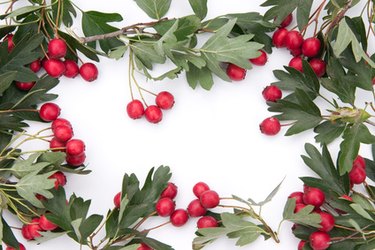
There are many varieties of Hawthorn (Crataegus) that produce edible, red berries and leaves.The rather small berries are cream-colored inside with a large stone in the center. The taste is slightly sweet with a more unpalatable aftertaste when eaten raw. Hawthorn berries are not commonly used as an edible fruit since the taste is not particularly special compared to the wide variety of fruits found today, however, the berries are quite delicious when made into jams, jellies or preserves, and they are very high in vitamin C.
Douglas Hawthorn
Video of the Day
The Douglas Hawthorn, or Black Hawthorne (Crataegus douglasii), is a variety of hawthorn that grows to a height of 30 feet. Like many other hawthorns, the berries of C. douglasii have been used to produce a concoction beneficial as a heart tonic. The berries are produced in large clusters and can be picked off the tree and eaten raw or boiled and simmered to make a jam or dessert. It is an easy and hardy plant to grow and will begin to bear fruit in five to nine years like most hawthorns.
Video of the Day
Chinese Hawthorn
Crateagus pinnatifida grows in China. It produces fruit that looks similar to the crab apple. The Chinese use the berries to make snacks and Haw flakes, a dark pink candy. They also produce a snack called tanghulu, which is made from candied haw fruits. As with other hawthorns, the berries are used to create jams, jellies and preserves. The Chinese hawthorn can also be used to make an alcoholic beverage. The plant has been an important food source in China for centuries, as well as a source of medicinal tonic.
One-Seed Hawthorn
The Crataegus Monogyna, or One-Seed Hawthorn, is a common wild hawthorn producing white blooms and red, edible berries. These are very popular with birds as a food source but are also edible to humans. The berries can be dried and ground to use as a coffee substitute, or added in baking, in addition to being consumed in jellies, jams and preserves. The berries and leaves are used medicinally to treat heart problems, enhance memory and treat malaria.
Mexican Hawthorn
Crataegus pubescens is the Mexican hawthorn (tejocote), native to the mountainous regions of Mexico. The large, crab–apple-like fruits are eaten raw, as jam, or cooked and placed in pinatas during Christmas celebration festivities. They are also a main ingredient in a traditional, hot fruit punch known as "ponche." Candy is made from the berries to use as offerings on the Day of the Dead. Pectin is extracted from the fruit. It is one of the most valuable of the hawthorn plants as a food source.
Hawthorn as a Food Source
The hawthorn plant is used worldwide and there are numerous species. The berries are the most used part of the plant, however, the leaves are also added in salads or soups, and the whole plant has numerous medicinal properties.